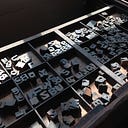Flannery O’Connor Childhood Home
207, East Charlton Street
Savannah, Georgia
This is the second part of a photographic and written account of my journey to Savannah, Georgia, and of what I discovered there about Flannery O’Connor and her childhood. Once again, I would like to thank Mr. Toby Aldrich for the incredible guided tour of the Flannery O’Connor Childhood Home, and Mrs. Christine Sajecki, the President of the Flannery O’Connor Childhood Home Board of Directors, for her interest in my project and her kind words of appreciation and encouragement. They have both been precious resources and there is no way I could thank them enough.
Exactly a week ago, I was walking around Flannery O’Connor’s Childhood Home, in Savannah, Georgia, snooping around as an intruder in someone else’s private space. Indeed, this is exactly what I was — a stranger entering one of the Flannery O’Connor’s most sacred space: her bathroom. It may seems crazy — or at least peculiar — that this was one of young Mary Flannery’s favorite spots in the entire house, but beside the backyard where the chickens were and her bedroom, the two bathrooms of the house in Charlton Street were her personal retreat from the rest of the world. There she kept some of her books and there she brought her friends — or we should say, the children her mother invited over to play with her, as, since she decided she was an adult, she did not like to play with them. However, when children did go to her house to play, she used to bring them up to the bathroom — which she had carefully decorated with flowers and strawberry leaves from her backyard garden — , make them sit in the bathtub — she even provided pillows to make them comfortable — and ask them to read stories out loud.
“O’Connor sometimes led a friend or two upstairs in the family house to her secret attic, a third floor kept for guests. In a remote bathroom, she liked to sit back in a large bathtub supported on porcelain feet, disconnected from any plumbing, and have her friends read aloud from her latest works.”
Brad Gooch, Flannery: A Life of Flannery O’Connor
Even though her favorite retreat was on the third floor of the house — presently not accessible to visitors — this room gives the idea of what it was like to be invited over for an afternoon at the O’Connors. As Brad Gooch recounts, she used these readings as an occasion to edit her first works, as she sometimes asked her friends to stop reading and start over again. Most of the times, though, she preferred to read something else — something she absolutely knew none of her friends would like and that would have certainly made them go home early. Indeed, when she started reading Grimm’s fairy tales every one would complain and one by one the little playmates would leave her alone. And this was exactly what she wanted, since it meant that she would eventually been able to enjoy the peace and quite of the room on her own. After all, she had gone through all the trouble of decorating her refuge only because she knew she would have been able to have it all for herself.
It should be pretty obvious by now that she loved spending time alone and reading stories ever since she was a child. This is perhaps why she was often considered a shy and lonely little girl, even though she preferred to describe herself as “a pidgeon-toed, only-child with a receding chin and a you-leave-me-alone-or-I’ll-bite-you complex.” In other words, she just knew what she wanted and did everything she could to obtain it. Had she wanted her playmates to go home early, she would have found a way to do it without getting in trouble with her parents. As a matter of fact, Grimm’s fairy tales, however dark and gruesome, were a perfectly acceptable book: it was not her fault if children could not appreciate it as much as she did.
Once in her room, Mary Flannery would behave in the same determinate way, even though this meant risking her mother’s reproach. One of he thing she liked most was to put her bed under the windows during the summer, while her mother was against it because it would have meant letting her have access to an extra playground — the roof. However, when her parents woke up in the morning, her bed would always be under the window, which was left open to let the breeze come in. She was not an easy child — or, as she believed, she was not a child at all — but this is only a sign of how strong her personality was. When things did no go the way she wanted, she was not happy at all: and this is what her facial expression says in this school photograph taken on a day in which all the children were dressed as Mickey Mouse. We can almost hear her think: “What a childish, silly thing.”
Besides reading, Flannery O’Connor loved drawing, even though the subjects of her stories and those of her drawings were always the same: chickens — and birds in general. These were probably the first signs of her life-long interest in and passion for these animals, but it is also a clear evidence of her early interest in both reading and drawing.
“The six-year-old girl was much more likely to be found upstairs, secluded, in her small, pine-floored corner bedroom, with one east window facing Katie Semmes’s home, and two rear windows looking down into the family’s walled backyard and the Charlton Lane service alley behind. In this hideaway, sparsely furnished with two single, matching, unpainted, pine beds […], a little green doll’s bed, and a narrow closet full of clothes, many sewn for her by her mother, she kept the precious crayons and paper she preferred as gifts to candy and sweets. Removed from all the comings and goings downstairs, she spent most of her free time making drawings, usually of birds. As she later wrote of her sketches to her friend Betty Hester, ‘I suppose my father toted around some of my early productions. I drew — mostly chickens, beginning at the tail, he same chicken over and over, beginning at the tail.’”
Brad Gooch, Flannery: A Life of Flannery O’Connor
“Just across the square from the childhood home is the formidable Cathedral of St. John the Baptist, where Mary Flannery O’Connor was baptized on April 12, 1925, where she made her First Communion on May 8, 1932, and where she was confirmed on May 20, 1934.”
Sarah Gordon, A Literary Guide to Flannery O’Connor’s Georgia
The last room of the house is Regina and Edward O’Connor’s bedroom, where the curious visitor can still see other items which belonged to the family. The most interesting thing, however, is the view beyond the windows: the Cathedral of St. John the Baptist, which young Flannery O’Connor was able to see in all its magnificence every day during her childhood years, when the view was not prevented by the trees. This is the same church she attended when she lived in Savannah, and where her strong faith was born and was cultivated.
Once the journey was over, I caught myself thinking about how many things from O’Connor’s childhood have made their way into both her adult life and her writings: not only her fictions usually portray themes which are incredibly close to her life experience; but she also critically reflected about these same issues in the essays collected in Mystery and Manners: Occasional Prose (1969). Starting from the first essay, “The King of the Birds,” this collection focuses on fundamental ideas of her production and important aspects of her life: from the meaning of religion to the role and identity of the Southern writers; from the question of teaching literature to the process of writing itself. It is exactly through the pages of her collected “occasional prose” that my journey will continue.

